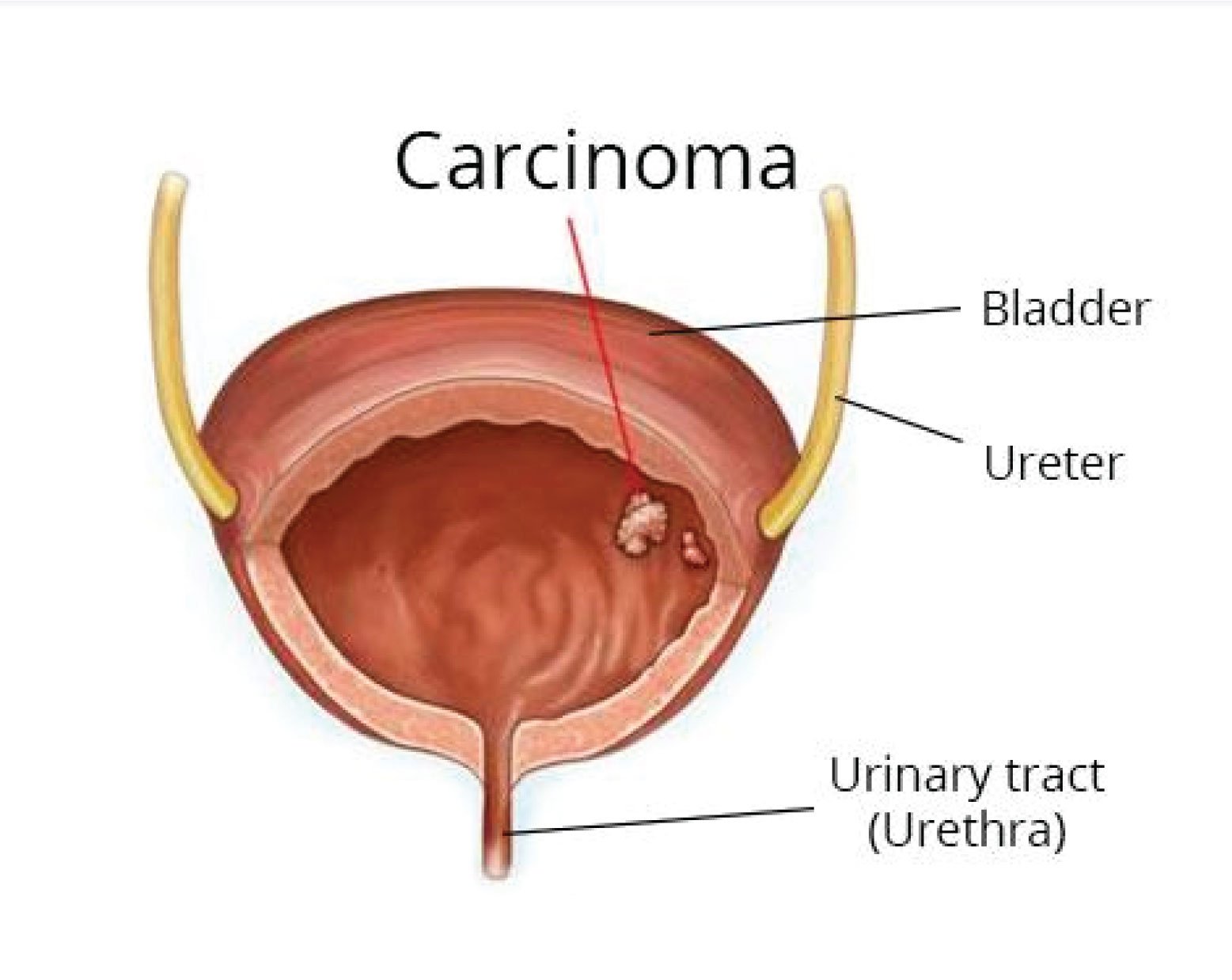Introduction
The bladder is a hollow organ in the pelvis that stores urine before it leaves the body during urination. The urinary tract is also made up of the kidneys, ureters, and urethra. The renal pelvis is a funnel-like part of the kidney that collects urine and sends it into the ureter. The ureter is a tube that runs from each kidney into the bladder. The urethra is the tube that carries urine out of the body.
Bladder cancer begins when healthy cells in the bladder lining change and grow out of control, forming a mass called a tumor. A tumor can be malignant or benign. Signs and symptoms of bladder cancer include blood in the urine and pain during urination. Tests that examine the urine and bladder are used to diagnose bladder cancer
Risk factors
- Using tobacco, especially smoking cigarettes.
- Having a family history of bladder cancer.
- Having certain changes in the genes that are linked to bladder cancer.
- Being exposed to paints, dyes, metals, or petroleum products in the workplace.
- Past treatment with radiation therapy to the pelvis or with certain anticancer drugs, such as cyclophosphamide or ifosfamide.
- Taking Aristolochia fangchi, a Chinese herb.
- Drinking water from a well that has high levels of arsenic.
- Drinking water that has been treated with chlorine.
- Having a history of bladder infections, including bladder
- infections caused by Schistosoma haematobium.
- Using urinary catheters for a long time.
- Older age is a risk factor for most cancers. The chance of getting cancer increases as you get older.
Types of bladder cancer
- Transitional cell carcinoma: Cancer that begins in cells in the innermost tissue layer of the bladder. Most bladder cancers begin in the transitional cells.
- Squamous cell carcinoma: Cancer that begins in squamous cells (thin, flat cells lining the inside of the bladder). Cancer may form after long-term infection or irritation.
- Adenocarcinoma: Cancer that begins in glandular cells that are found in the lining of the bladder. Glandular cells in the bladder make substances such as mucus. This is a very rare type of bladder cancer.
Stages of Bladder Cancer
After bladder cancer has been diagnosed, tests are done to find out if cancer cells have spread within the bladder or to other parts of the body.
The following stages are used for bladder cancer:
- Stage 0 (Noninvasive Papillary Carcinoma and Carcinoma in Situ):
Abnormal cells are found in tissue lining the inside of the bladder. These abnormal cells may become cancer and spread into nearby normal tissue.
- Stage I:
Cancer has formed and spread to the layer of connective tissue next to the inner lining of the bladder .
- Stage II:
cancer has spread to the layers of muscle tissue of the bladder.
- Stage III: Stage III is divided into stages IIIA and IIIB.
- Stage IIIA:
cancer has spread from the bladder to the layer of fat surrounding the bladder and may have spread to the reproductive organs (prostate, seminal vesicles, uterus, or vagina)
- Stage IIIB:
cancer has spread from the bladder to more than one lymph node in the pelvis
- Stage IV:
Stage IV is divided into stages IVA and IVB.
- Stage IVA:
Cancer has spread from the bladder to the wall of the abdomen or pelvis or one lymph node.
- Stage IVB,
cancer has spread to other parts of the body, such as the lung, bone, liver.
- Bladder cancer can recur (come back) after it has been treated.
Signs and Symptoms
- Blood or blood clots in the urine.
- Pain or burning sensation during urination.
- Frequent urination.
- Feeling the need to urinate many times throughout the night.
- Feeling the need to urinate, but not being able to pass urine.
- Lower back pain on 1 side of the body.
Diagnosis
- Urine tests:
- Urinalysis: This is a simple lab test to check for blood and other substances in a sample of urine
- Urine culture: this test may be done to see if an infection is the cause
- Urine cytology: A laboratory test in which a sample of urine is checked for abnormal cells.
- Cystoscopy:
A specialist will examine the inside of your bladder by passing a thin tube with a camera and light at the end (cystoscope) through your urethra Before having a cystoscopy, a local anesthetic gel is applied to your urethra so you don’t feel any pain
- Biopsy/Transurethral resection of bladder tumor (TURBT):
A biopsy is the removal of a small amount of tissue for examination under a microscope. This surgical procedure is called a transurethral bladder tumor resection or TURBT.
- Computed tomography (CT or CAT) scan:
CT scan can be used to measure the tumor’s size and to identify enlarged lymph nodes, which may indicate that cancer has spread.
- Magnetic resonance imaging (MRI):
An MRI uses magnetic fields, to produce detailed images of the body. MRI can be used to measure the tumor’s size and to identify enlarged lymph nodes, which may indicate that cancer has spread.
- Positron emission tomography (PET) or PET-CT scan.
A PET scan is a way to create pictures of organs and tissues inside the body.
- Ultrasound:
An ultrasound helps to find out if the kidneys or ureters are blocked.
Treatment
Treatment options for bladder cancer depend on type of cancer, grade of the cancer and stage of the cancer,
- Surgery: to remove the cancer cells. The types of surgery can be Transurethral resection (TUR) with fulguration, Radical cystectomy, Partial cystectomy Urinary diversion( Surgery to make a new way for the body to store and pass urine)
- Chemotherapy in the bladder (intravesical chemotherapy : Chemotherapy is a cancer treatment that uses drugs to stop the growth of cancer cells, either by killing the cells or by stopping them from dividing. For bladder cancer, regional chemotherapy may be intravesical (put into the bladder through a tube inserted into the urethra).
- Chemotherapy for the whole body (systemic chemotherapy): to increase the chance for a cure in a person having surgery to remove the bladder, or as a primary treatment when surgery isn’t an option
- Radiation therapy: to destroy cancer cells, often as a primary treatment when surgery isn’t an option or isn’t desired
- Immunotherapy: to trigger the body’s immune system to fight cancer cells, either in the bladder or throughout the body
- Targeted therapy: to treat advanced cancer when other treatments haven’t helped
After bladder cancer treatment
Bladder cancer may recur, even after successful treatment. Because of this, people with bladder cancer need follow-up testing for years after successful treatment. What tests you’ll have and how often depends on your type of bladder cancer and how it was treated, among other factors.
In general, doctors recommend a test to examine the inside of your urethra and bladder (cystoscopy) every three to six months for the first few years after bladder cancer treatment. After a few years of surveillance without detecting cancer recurrence, you may need a cystoscopy exam only once a year. Your doctor may recommend other tests at regular intervals as well.
Disclaimer: All contents on this site are for general information and in no circumstances, information be substituted for professional advice from the relevant healthcare professional, Writer does not take responsibility for any damage done by the misuse or use of the information.
REFFERANCES
https://www.mayoclinic.org/ Myoclinic
https://www.cancer.net/ Cancer net ASCO

